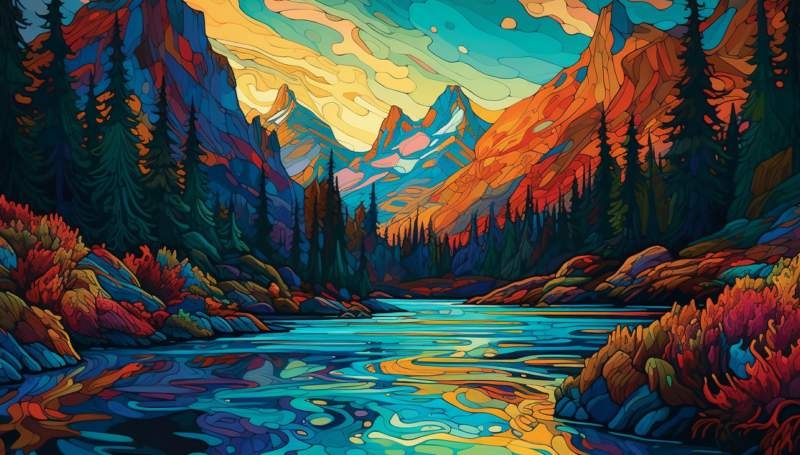Delving into the Psychotropic Influence in Graphic Design

A Brief History: Unraveling the Neon ThreadsPsychotropic substances have long been associated with the creative process – from the ancient Greeks imbibing the Kykeon brew to the modern-day psychonauts exploring the far reaches of their consciousness. It's no wonder that graphic design, which is often a visual representation of complex ideas and emotions, has been influenced by the mind-altering effects of these substances.
Let us journey back in time to the '60s and '70s, when psychedelia and counter-culture movements were at their peak. This was a time when kaleidoscopic patterns and vivid colors became synonymous with the mind-expanding substances that fueled the work of artists such as Wes Wilson, Victor Moscoso, and Rick Griffin. Their vibrant posters advertising rock concerts and happenings were a visual manifestation of the era's cultural shift – a marriage of art and psychotropic experiences that would forever change the course of graphic design.
A Visual Panorama: The Hallmarks of a Psychotropic-Inspired DesignSo, what makes a design "psychotropic-inspired"? Let us examine the common attributes that tend to manifest in the minds of those who have ventured into the great beyond of altered states:
- Vibrant Colors: Perhaps the most obvious characteristic of psychotropic-inspired design is the use of bright, vivid colors that seem to pulsate with life. Far from the conservative color palettes of the '50s, these designs embrace the full spectrum of color, often employing contrasting hues to create a sense of visual tension.
- Organic Shapes: The undulating lines and fluid forms found in these designs evoke a sense of natural growth and movement. Often, these organic shapes will interconnect and blend into one another, creating a sense of unity and interconnectedness.
- Visual Distortions: Psychotropic substances have a way of skewing our perceptions, and this is reflected in the visual distortions and optical illusions commonly found in such designs. Typography may appear to melt and flow, while geometric patterns may seem to pulsate and shift before our very eyes.
- Symbolism: Symbols and icons from various spiritual and mystical traditions are often woven into the fabric of these designs, hinting at the deeper truths and insights that may be gained through altered states of consciousness.
While these characteristics are by no means exhaustive, they offer a glimpse into the visual language of psychotropic-inspired design – a language that continues to evolve and adapt as new generations of artists and designers explore their own inner realms.
Practical Advice for Harnessing Your Inner PsychonautYou need not traverse dimensions to tap into the psychotropic-inspired design style. Here are some practical tips to help you incorporate this aesthetic into your own work:
- Embrace Color: Don't shy away from using bold, vibrant colors in your designs. Experiment with different color combinations and see how they interact with one another – sometimes the most unexpected pairings can yield the most striking results.
- Break Free from the Grid: Rigid, structured layouts have their place, but psychotropic-inspired designs often thrive on a sense of fluidity and organic movement. Try incorporating free-form shapes and elements into your work, and see how they can breathe new life into your designs.
- Play with Perception: Optical illusions and visual distortions can add an element of intrigue and depth to your designs. Look for ways to play with perspective and scale, and don't be afraid to bend the rules of reality a bit.
- Seek Inspiration: The world is full of visual stimuli that can inspire your work. From the intricate patterns found in nature to the sacred geometry of ancient temples, keep your eyes and mind open to the myriad ways the psychotropic aesthetic can manifest itself.
Remember, the goal is not to mimic or replicate the work of the psychotropic-inspired artists who came before us, but to use their creations as a springboard to explore your own unique style and vision.
A Trip That Never Ends: The Lasting Influence of Psychotropic DesignAlthough the heyday of psychedelic art and design may have waned, its influence can still be felt today. From the trippy visuals of music festivals and album covers to the resurgence of interest in sacred geometry and entheogens, the psychotropic aesthetic continues to permeate our culture.
At its core, psychotropic-inspired design is about transcending the boundaries of our everyday reality and exploring the inner workings of the human mind. As long as there are those who are willing to push the limits of their creativity and dare to venture into the unknown, the psychotropic influence in graphic design will continue to evolve and remain a vital element in the world of visual art.
|
|







